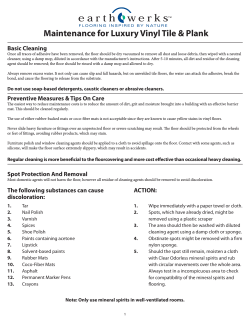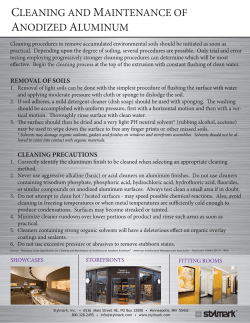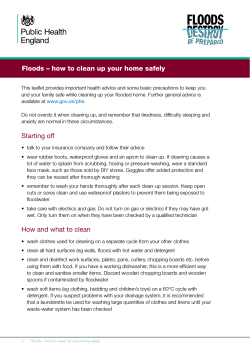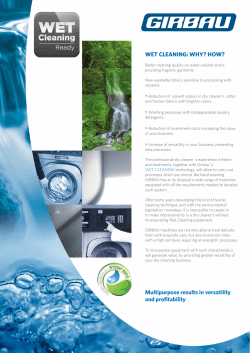
I
Use of electrolysed water to clean near-patient sites: is disinfectant better than detergent? Stewart M1, Bogusz A1, Hunter J1, Devanny I1, Yip B1, Reid D1, Robertson C2-4, Dancer SJ1 Hairmyres Hospital, NHS Lanarkshire 1 University of Strathclyde, Glasgow 2 Health Protection Scotland, Glasgow 3 International Prevention Research Institute, Lyon 4 Introduction Hospital cleanliness is important for controlling infection. UK hospitals are routinely cleaned with detergent, although bleach is required for specific pathogens or outbreaks. Electrolysed water is a stable form of hypochlorous acid (Ph. 6-8) produced after passing an electric current through salt water.1 The product is biocidal and has been tested in community care homes.2,3 We aimed to evaluate cleaning with electrolysed water using total aerobic colony counts (ACC/cm2) and S.aureus (MSSA and MRSA). We also compared this disinfectant against detergent using data from a previous study. 4 Methods Four sites (bedside locker; left cot-side; overbed table; right cot-side) around 30 beds in a medical ward were screened using dipslides (Hygiena Int., Watford, UK), coated with nutrient and staphylococcal (Baird Parker) agars. These were processed according to standards for assessing surface cleanliness.4-7 After screening, each site was sprayed with 1.5 ml electrolysed water (Aqualution Ltd., UK), and wiped with single-use detergent wipes (Vernacare Ltd, Bolton, UK). Sites were rescreened at 1 hour; 2; 4; 8; 12; 24; and 48 hours after cleaning, and the study repeated three times. There were no outbreaks of MSSA or MRSA. A previous study with detergent was conducted on an identical ward in the same unit using the same methods.4 Results Total ACC quickly decreased at each site after cleaning with electrolysed water (red line: Fig.1). Electrolysed water reduced pre-clean ACC from 4.3 cfu/cm2 to 1.65 cfu/cm2 at one hour post-cleaning (p<0.0001). ACC then increased to 3.68 cfu/cm2 at 48 hours after cleaning, which was lower than the pre-clean level. Electrolysed water had a different effect on MSSA/MRSA. The highest levels were found at 24 hours, not 48 hours, after cleaning (red line: Fig. 2). Total staphylococci reduced by 71% from 34 isolates (pre-cleaning) to 10 isolates (29%) at 4 hours after cleaning. Numbers then increased to 53 isolates (155%) at 24 hours, and 36 isolates (106%) at 48 hours. The bed-side locker yielded the highest number of staphylococci overall. Effect of detergent and disinfectant-based cleaning on total aerobic colony counts (ACC/cm2) at hand-touch sites on one 30-bed ward over 48 hours Figure 1 Effect of detergent and disinfectant-based cleaning on total MSSA/MRSA at hand-touch sites on one ward over 48 hours Figure 2 Discussion Disinfectant cleaning rapidly decreased ACC at near-patient sites, with levels at 48 hours the same or less than those obtained before cleaning. In contrast, MSSA/MRSA were not completely eradicated and demonstrated an unexpected surge at 24 hours. These results were compared against data from the detergent study. Overall ACC decreased more rapidly after electrolysed water to reach a relatively lower level (Fig.1), but there was little difference between the two types of cleaning at 48 hours.4 Total MSSA/MRSA decreased to a minimum level at four hours in both studies, but whilst counts did not reach pre-clean levels at 48 hours after detergent, the numbers retrieved 24 hours after disinfectant greatly superseded original levels. In conclusion, cleaning with electrolysed water reduced ACC at sites around patients’ beds on an acute ward. ACC remained below pre-clean counts at 48 hours but MSSA/MRSA did not. While disinfectant quickly reduces surface bioburden, it is not necessarily superior to detergent if there is rebound contamination with pathogens on near-patient surfaces.8 References 1. Thorn RMS et al. Eur J Clin Micro Infect Dis 2011. 2. Deza MA et al. Lett Appl Microbiol 2005. 3. Meakin N et al. J Hosp Infect 2012. 4. Bogusz A et al. Healthcare Infect 2013. 5. 6. 7. 8. Dancer SJ et al. BMC Med 2009. Dancer SJ. J Hosp Infect 2004. Dancer SJ et al. Int J Environ Hygiene 2008. Dancer SJ. J Hosp Infect 2009.
© Copyright 2025











